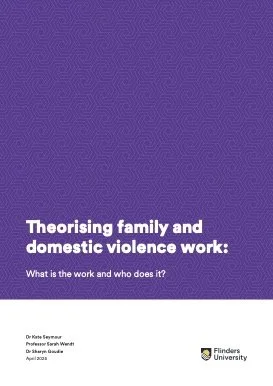Theorising family and domestic violence work: what is the work and who does it?
By Kate Seymour, Sarah Wendt,Sharyn Goudie
Family and domestic violence (FDV) is a widespread social issue in Australia with significant health, welfare, and economic consequences. While the FDV workforce is increasingly recognised, at both the Commonwealth and state/territory levels, as a key piece of the puzzle in addressing FDV in Australia, there remains limited understanding of the work itself.
This report describes research exploring the domestic and family violence workforce in Australia and the work that it undertakes. It focuses specifically on how the work is done and experienced, why it is done in particular ways, and the structural and organisational contexts that shape this work.
The aims of the research were to:
generate a coherent, qualitative evidence base on the nature and experiences of domestic and family violence work across three key domains: victim services, perpetrator services and Aboriginal specialist services
conceptualise the domestic and family violence workforce with reference to the nature of the work across these three domains
recommend workforce development strategies that are responsive to the context and needs of domestic and family violence work.
Key findings
The diverse sociocultural and institutional contexts within which organisations operated shaped understandings of violence as well as perceptions of the skills and capacities that constitute, or are valued in, domestic and family violence work.
DFV services (like other social welfare services) are subject to budget rationalisation, narrow funding models, and competition for government contracts and funding. This was evident across all organisations but was especially marked in victim services in the form of an intensified pace & volume of work, and accountability to funding bodies.
Differences in work conditions were observed across the victim and perpetrator service sectors, suggesting a gendered demarcation between women’s work (victim support – caring work, femininised and devalued) and men’s work (perpetrator accountability – challenging, ‘man-to-man’).
The weight of responsibility associated with managing risk was especially acute for workers in victim services but relatively absent in perpetrator services where ‘high risk’ matters (i.e. immediate safety concerns) were diverted to a designated partner contact worker.
Community and social activism were central to the work in Aboriginal FDV services as workers dealt daily with the enduring and deeply entrenched impacts of colonisation.
Adelaide: Flinders University, 2025. 96p.


